Visual Analysis of Research Progress on the Impact of Cadmium Stress on Horticultural Plants over 25 Years
Abstract
1. Introduction
2. Materials and Methods
2.1. Data Sources
2.2. Analysis Method
3. Results and Discussion
3.1. Temporal Distribution of Publications on “Horticultural Plants-Cd Responses”
3.2. Spatial Distribution of Publications on “Horticultural Plants-Cd Responses”
3.2.1. Countries’ Cooperation Networks
3.2.2. Authors’ Cooperation Networks
3.2.3. Institution Cooperation Networks
3.3. Visual Analysis of Intellectual Base on “Horticultural Plants-Cd Responses”
3.4. Visual Analysis of Research Hotspots on”Horticultural Plants-Cd Responses”
3.4.1. Keyword Co-Occurrence Network Analysis
3.4.2. Keyword Clustering Analysis
3.5. Visual Analysis of Dynamic Frontier
3.5.1. Evolution Trends
3.5.2. Research Frontiers
4. Conclusions and Outlook
- (1)
- Emphasize interdisciplinary research: Collaboration should be encouraged between different disciplines such as biology, soil science, environmental science, and public health to develop a comprehensive understanding of Cd stress and its impacts on agriculture and the environment.
- (2)
- Focus on biochar and co-stress studies: Since the global research frontier has shifted towards biochar and co-stress studies, Chinese researchers should focus more on how biochar can mitigate Cd stress and how plants respond to multiple stresses such as Cd and drought or exogenous substances.
- (3)
- Promote phytoremediation research: Research should be supported on phytoremediation techniques using horticultural plants that can hyperaccumulate Cd, such as Thlaspi caerulescens, Lonicera japonica Thunb., to remediate contaminated soils.
- (4)
- Invest in plant breeding and genetic engineering: Cd-resistant horticultural plant varieties should be developed through traditional breeding and genetic engineering techniques to reduce the impact of Cd on agriculture and food safety.
- (5)
- Leverage International Collaboration: International research institutions should collaborate to share knowledge, resources, and expertise and to stay abreast of the latest advancements in cadmium research.
- (6)
- Foster innovation in nanotechnology: The use of nanotechnology should be explored in addressing Cd stress, e.g., nanomaterials for soil remediation or nanosensors for monitoring Cd levels in horticultural plants and soil.
Author Contributions
Funding
Data Availability Statement
Conflicts of Interest
References
- Mukherjee, A.G.; Wanjari, U.R.; Renu, K.; Vellingiri, B.; Gopalakrishnan, A.V. Heavy metal and metalloid-induced reproductive toxicity. Environ. Toxicol. Pharmacol. 2022, 92, 103859. [Google Scholar] [CrossRef] [PubMed]
- Tomczyk, P.; Wdowczyk, A.; Wiatkowska, B.; Szymańska-Pulikowska, A. Assessment of heavy metal contamination of agricultural soils in Poland using contamination indicators. Ecol. Indic. 2023, 156, 111161. [Google Scholar] [CrossRef]
- Bai, S.Y.; Han, X.; Feng, D. Shoot-root signal circuit: Phytoremediation of heavy metal contaminated soil. Front. Plant Sci. 2023, 14, 1139744. [Google Scholar] [CrossRef] [PubMed]
- Huang, S.Q.; Lu, Z.Q.; Zhao, X.X.; Tan, W.B.; Wang, H.; Liu, D.L.; Xing, W. Molecular basis of energy crops functioning in bioremediation of heavy metal pollution. Agriculture 2024, 14, 914. [Google Scholar] [CrossRef]
- Zhu, W.G.; Zhu, D.Y.; He, J.M.; Lian, X.X.; Chang, Z.B.; Guo, R.C.; Li, X.H.; Wang, Y.L. Phytoremediation of soil co-contaminated with heavy metals (HMs) and tetracyclines: Effect of the co-contamination and HM bioavailability analysis. J. Soils Sediments 2022, 22, 2036–2047. [Google Scholar] [CrossRef]
- Borah, G.; Deka, H. Crude oil associated heavy metals (HMs) contamination in agricultural land: Understanding risk factors and changes in soil biological properties. Chemosphere 2023, 310, 136890. [Google Scholar] [CrossRef]
- Yılmaz, C.H. Heavy metals and their sources, potential pollution situations and health risks for residents in Adıyaman province agricultural lands, Türkiye. Environ. Geochem. Health 2023, 45, 3521–3539. [Google Scholar] [CrossRef]
- Du, Y.B.; Tian, Z.J.; Zhao, Y.F.; Wang, X.R.; Ma, Z.Z.; Yu, C.H. Exploring the accumulation capacity of dominant plants based on soil heavy metals forms and assessing heavy metals contamination characteristics near gold tailings ponds. J. Environ. Manag. 2024, 351, 119838. [Google Scholar] [CrossRef]
- Ma, J.Y.; Dong, X.M.; Yu, L.J.; Zhang, Y.H. Response and function of Solanum lycopersicum L. SlSGR2 gene under cadmium stress. Horticulturae 2022, 8, 1002. [Google Scholar] [CrossRef]
- Arruebarrena, M.A.; Hawe, C.T.; Lee, Y.M.; Branco, R.C. Mechanisms of cadmium neurotoxicity. Int. J. Mol. Sci. 2023, 24, 16558. [Google Scholar] [CrossRef]
- Long, H.Y.; Feng, G.F.; Fang, J. In-situ remediation of cadmium contamination in paddy fields: From rhizosphere soil to rice kernel. Environ. Geochem. Health 2024, 46, 404. [Google Scholar] [CrossRef] [PubMed]
- Iqbal, B.; Javed, Q.; Khan, I.; Tariq, M.; Ahmad, N.; Elansary, H.O.; Jalal, A.; Li, G.L.; Du, D.L. Influence of soil microplastic contamination and cadmium toxicity on the growth, physiology, and root growth traits of Triticum aestivum L. S. Afr. J. Bot. 2023, 160, 369–375. [Google Scholar] [CrossRef]
- Liu, Z.L.; Lu, Q.X.; Zhao, Y.; Wei, J.B.; Liu, M.; Duan, X.B.; Lin, M.S. Ameliorating effects of graphene oxide on cadmium accumulation and eco-physiological characteristics in a greening hyperaccumulator (Lonicera japonica Thunb.). Plants 2024, 13, 19. [Google Scholar] [CrossRef] [PubMed]
- Elbagory, M.; Farrag, D.K.; Hashim, A.M.; Omara, A.E.D. The combined effect of Pseudomonas stutzeri and biochar on the growth dynamics and tolerance of lettuce plants (Lactuca sativa) to cadmium stress. Horticulturae 2021, 7, 430. [Google Scholar] [CrossRef]
- Liu, Z.L.; Chen, M.D.; Lin, M.S.; Chen, Q.L.; Lu, Q.X.; Yao, J.; He, X.Y. Cadmium uptake and growth responses of seven urban flowering plants: Hyperaccumulator or bioindicator? Sustainability 2022, 14, 619. [Google Scholar] [CrossRef]
- Vemić, A.; Popović, V.; Miletić, Z.; Radulović, Z.; Rakonjac, L.; Lučić, A. Effect of cadmium (Cd) and lead (Pb) soil contamination on the development of Hymenoscyphus fraxineus on Fraxinus excelsior and F. angustifolia seedlings. Iforest 2023, 16, 307. [Google Scholar] [CrossRef]
- Wang, W.; Man, Z.; Li, X.L.; Zhao, Y.Y.; Chen, R.Q.; Pan, T.T.; Wang, L.P.; Dai, X.R.; Xiao, H.; Liu, F. Multi-phenotype response and cadmium detection of rice stem under toxic cadmium exposure. Sci. Total Environ. 2024, 917, 170585. [Google Scholar] [CrossRef]
- Chen, Y.; Wu, X.L.; Lin, Z.X.; Teng, D.Z.; Zhao, Y.M.; Chen, S.N.; Hu, X.F. Screening of cadmium resistant bacteria and their growth promotion of Sorghum bicolor (L.) Moench under cadmium stress. Ecotoxicol. Environ. Saf. 2024, 272, 116012. [Google Scholar] [CrossRef]
- Sivakoff, F.S.; McLaughlin, R.; Gardiner, M.M. Cadmium soil contamination alters plant-pollinator interactions. Environ. Pollut. 2024, 356, 124316. [Google Scholar] [CrossRef]
- Zhao, W.X.; Zhao, H.Y.; Wang, H.S.; He, Y. Research progress on the relationship between leaf senescence and quality, yield and stress resistance in horticultural plants. Front. Plant Sci. 2022, 13, 1044500. [Google Scholar] [CrossRef]
- Noor, I.; Sohail, H.; Sun, J.; Nawaz, M.A.; Li, G.; Hasanuzzaman, M.; Liu, J. Heavy metal and metalloid toxicity in horticultural plants: Tolerance mechanism and remediation strategies. Chemosphere 2022, 303, 135196. [Google Scholar] [CrossRef] [PubMed]
- Gao, F.; Zhang, X.D.; Zhang, J.; Li, J.; Niu, T.H.; Tang, C.N.; Wang, C.; Xie, J.M. Zinc oxide nanoparticles improve lettuce (Lactuca sativa L.) plant tolerance to cadmium by stimulating antioxidant defense, enhancing lignin content and reducing the metal accumulation and translocation. Front. Plant Sci. 2022, 13, 1015745. [Google Scholar] [CrossRef] [PubMed]
- Pan, Y.J.; Xu, X.N.; Lang, Q.Q.; Liao, S.Q.; Li, Y.M. Three different fertilizers enhance spinach growth and reduce spinach Cd concentration in Cd contaminated alkaline soil. Horticultura 2023, 9, 445. [Google Scholar] [CrossRef]
- Li, Y.T.; Gao, Y.; Chen, W.; Zhang, W.G.; Lu, X. Shifts in bacterial diversity, interactions and microbial elemental cycling genes under cadmium contamination in paddy soil: Implications for altered ecological function. J. Hazard. Mater. 2024, 461, 132544. [Google Scholar] [CrossRef]
- Zhao, X.Y.; Peng, J.; Zhang, L.; Yang, X.; Qiu, Y.J.; Cai, C.C.; Hu, J.T.; Huang, T.; Liang, Y.; Wang, Z. Optimizing the quality of horticultural crop: Insights into pre-harvest practices in controlled environment agriculture. Front. Plant Sci. 2024, 15, 1427471. [Google Scholar] [CrossRef]
- Liu, Z.L.; He, X.Y.; Chen, W.; Zhao, M.Z. Ecotoxicological responses of three ornamental herb species to cadmium. Environ. Toxicol. Chem. 2013, 32, 1746–1751. [Google Scholar] [CrossRef]
- Aslam, M.M.; Okal, E.J.; Waseem, M. Cadmium toxicity impacts plant growth and plant remediation strategies. Plant Growth Regul. 2023, 99, 397–412. [Google Scholar] [CrossRef]
- Liu, C.C.; Wen, L.; Cui, Y.J.; Ahammed, G.J.; Cheng, Y. Metal transport proteins and transcription factor networks in plant responses to cadmium stress. Plant Cell Rep. 2024, 43, 218. [Google Scholar] [CrossRef]
- Ziaf, K.; Talha, H.M.; Ghani, M.A.; Ahmad, I.; Anwar, R.; Ali, B.; Majeed, Y.; Shakeel, A.; Iqbal, M.; Zaid, A. Differential accumulation pattern of cadmium in plant parts of pea varieties in response to varying cadmium levels. S. Afr. J. Bot. 2023, 161, 599–606. [Google Scholar] [CrossRef]
- Moravčíková, D.; Žiarovská, J. The effect of cadmium on plants in terms of the response of gene expression level and activity. Plants 2023, 12, 1848. [Google Scholar] [CrossRef]
- Liu, Z.L.; Chen, W.; He, X.Y.; Jia, L.; Huang, Y.Q.; Zhang, Y.; Yu, S. Cadmium-induced physiological response in Lonicera japonica Thunb. Clean-Soil Air Water 2013, 41, 478–484. [Google Scholar] [CrossRef]
- Hassan, H.; Elaksher, S.H.; Shabala, S.; Ouyang, B. Cadmium uptake and detoxification in tomato plants: Revealing promising targets for genetic improvement. Plant Physiol. Biochem. 2024, 214, 108968. [Google Scholar] [CrossRef] [PubMed]
- Liu, J.; Kang, L.Y.; Du, L.F.; Liao, S.Q.; Dong, W.; Ma, M.T.; Zou, G.Y.; Li, S.J. Distribution, accumulation and translocation of the heavy metal Cd in various varieties of edible rapeseed under Cd stress. Sustainability 2024, 16, 2876. [Google Scholar] [CrossRef]
- Ndlovu, S.; Pullabhotla, R.V.; Ntuli, N.R. Response of Corchorus olitorius leafy vegetable to cadmium in the soil. Plants 2020, 9, 1200. [Google Scholar] [CrossRef]
- Szerement, J.; Szatanik-Kloc, A. Cell-wall pectins in the roots of Apiaceae plants: Adaptations to Cd stress. Acta Physiol. Plant. 2022, 44, 53. [Google Scholar] [CrossRef]
- Jia, K.Y.; Zhan, Z.P.; Wang, B.Q.; Wang, W.H.; Wei, W.J.; Li, D.W.; Huang, W.; Xu, Z.M. Exogenous selenium enhances cadmium stress tolerance by improving physiological characteristics of cabbage (Brassica oleracea L. var. capitata) seedlings. Horticulturae 2023, 9, 1016. [Google Scholar] [CrossRef]
- Liu, Z.L.; He, X.Y.; Chen, W. Effects of cadmium hyperaccumulation on the concentrations of four trace elements in Lonicera japonica Thunb. Ecotoxicology 2011, 20, 698–705. [Google Scholar] [CrossRef]
- Chen, L.; Hu, W.F.; Long, C.; Wang, D. Exogenous plant growth regulator alleviate the adverse effects of U and Cd stress in sunflower (Helianthus annuus L.) and improve the efficacy of U and Cd remediation. Chemosphere 2021, 262, 127809. [Google Scholar] [CrossRef]
- Huang, Y.F.; Chen, J.H.; Sun, Y.M.; Wang, H.X.; Zhan, J.Y.; Huang, Y.N.; Zou, J.W.; Wang, L.; Su, N.N.; Cui, J. Mechanisms of calcium sulfate in alleviating cadmium toxicity and accumulation in pak choi seedlings. Sci. Total Environ. 2022, 805, 150115. [Google Scholar] [CrossRef]
- Wang, H.F.; Xu, Y.X.; Yang, M.Q.; Jin, X.; Li, X.F.; Dai, Z.; Zhang, D.L.; Zhou, K.X.; Lin, L.J.; Wang, J. Exogenous strigolactone improves the cadmium accumulation in Solanum nigrum var. Humile. Environ. Prog. Sustain. Energy 2024, 43, 14379. [Google Scholar] [CrossRef]
- Xu, Z.P.; Shao, T.J.; Dong, Z.B.; Li, S.L. Research progress of heavy metals in desert—Visual analysis based on CiteSpace. Environ. Sci. Pollut. R. 2022, 29, 43648–43661. [Google Scholar] [CrossRef] [PubMed]
- Geng, Y.Q.; Zhang, N.G.; Zhu, R.J. Research progress analysis of sustainable smart grid based on CiteSpace. Energy Strategy Rev. 2023, 48, 101111. [Google Scholar] [CrossRef]
- Chen, J.H.; Liu, X.R.; Zhou, S.R.; Kang, J. Knowledge mapping analysis of resilient shipping network using CiteSpace. Ocean Coast. Manag. 2023, 244, 106775. [Google Scholar] [CrossRef]
- Li, H.K.; Li, B. The state of metaverse research: A bibliometric visual analysis based on CiteSpace. J. Big Data 2024, 11, 14. [Google Scholar] [CrossRef]
- Geng, Y.Q.; Jiang, X.Y.; Bai, W.Q.; Yan, Y.; Gao, J. Research progress of tourism marketing over 30 years: Bibliometrics based on CiteSpace. Ecol. Indic. 2024, 162, 112059. [Google Scholar] [CrossRef]
- Xiao, Y.T.; Sun, C.X.; Wang, D.Z.; Li, H.Q.; Guo, W. Analysis of hotspots in subsurface drip irrigation research using CiteSpace. Agriculture 2023, 13, 1463. [Google Scholar] [CrossRef]
- Ye, H.R.; Du, Y.; Jin, Y.T.; Liu, F.Y.; He, S.S.; Guo, Y.H. Articles on hemorrhagic shock published between 2000 and 2021: A CiteSpace-Based bibliometric analysis. Heliyon 2023, 9, e18840. [Google Scholar] [CrossRef]
- Wang, F.R.; Tan, B.; Chen, Y.; Fang, X.Y.; Jia, G.W.; Wang, H.Y.; Chen, G.; Shao, Z.Z. A visual knowledge map analysis of mine fire research based on CiteSpace. Environ. Sci. Pollut. R. 2022, 29, 77609–77624. [Google Scholar] [CrossRef]
- Huang, J.H.; Xiang, S.; Chen, S.Q.; Wu, W.; Huang, T.Y.; Pang, Y. Perfluoroalkyl substance pollution: Detecting and visualizing emerging trends based on CiteSpace. Environ. Sci. Pollut. R. 2022, 29, 82786–82798. [Google Scholar] [CrossRef]
- Chen, J.H.; Zhang, X.T.; Xu, L.; Xu, J.H. Trends of digitalization, intelligence and greening of global shipping industry based on CiteSpace Knowledge Graph. Ocean Coast. Manag. 2024, 255, 107206. [Google Scholar] [CrossRef]
- Cui, L.H.; Tang, W.J.; Deng, X.S.; Jiang, B. Farm animal welfare is a field of interest in China: A bibliometric analysis based on CiteSpace. Animals 2023, 13, 3143. [Google Scholar] [CrossRef] [PubMed]
- Yuan, X.Y.; Lai, Y. Bibliometric and visualized analysis of elite controllers based on CiteSpace: Landscapes, hotspots, and frontiers. Front. Cell. Infect. Microbiol. 2023, 13, 1147265. [Google Scholar] [CrossRef] [PubMed]
- Mamat, M.; Li, L.; Kang, S.F.; Chen, Y.Y. Emerging trends on the anatomy teaching reforms in the last 10 years: Based on VOSviewer and CiteSpace. Anat. Sci. Educ. 2024, 17, 722–734. [Google Scholar] [CrossRef] [PubMed]
- Li, H.B.; Xiang, Y.R.; Yang, W.J.; Lin, T.; Xiao, Q.K.; Zhang, G.Q. Green roof development knowledge map: A review of visual analysis using CiteSpace and VOSviewer. Heliyon 2024, 10, e24958. [Google Scholar] [CrossRef] [PubMed]
- Che, S.P.; Kamphuis, P.; Zhang, S.; Zhao, X.Y.; Kim, J.H. A visualization analysis of crisis and risk communication research using CiteSpace. Int. J. Environ. Res. Public Health 2022, 19, 2923. [Google Scholar] [CrossRef]
- Yang, X.F.; Liu, Q.F. Research foundation and hotspot analysis of urban road ecology—A bibliometric study based on CiteSpace. Sustainability 2024, 16, 5135. [Google Scholar] [CrossRef]
- Li, X.; Du, J.; Long, H. A comparative study of Chinese and foreign green development from the perspective of mapping knowledge domains. Sustainability 2018, 10, 4357. [Google Scholar] [CrossRef]
- Qiu, Y.R.; Liao, K.H.; Zou, Y.T.; Huang, G.Z. A bibliometric analysis on research regarding residential segregation and health based on CiteSpace. Int. J. Environ. Res. Public Health 2022, 19, 10069. [Google Scholar] [CrossRef]
- Hu, W.; Li, C.; Ye, C.; Wang, J.; Wei, W.; Deng, Y. Research progress on ecological models in the field of water eutrophication: CiteSpace analysis based on data from the ISI web of science database. Ecol. Model. 2019, 410, 108779. [Google Scholar] [CrossRef]
- Liu, C.; Yuan, Y.; Zhou, A.H.; Guo, L.F.; Zhang, H.R.; Liu, X.D. Development trends and research frontiers of preferential flow in soil based on CiteSpace. Water 2022, 14, 3036. [Google Scholar] [CrossRef]
- Wang, B.; Liu, J.; Liu, Q.; Sun, J.B.; Zhao, Y.X.; Liu, J.; Gao, W.S.; Chen, Y.Q.; Sui, P. Knowledge domain and research progress in the field of crop rotation from 2000 to 2020: A scientometric review. Environ. Sci. Pollut. Res. 2023, 30, 86598–86617. [Google Scholar] [CrossRef] [PubMed]
- Wu, L.J.; Miao, H.Y.; Liu, T.Z. Development in agricultural ecosystems’ carbon emissions research: A visual analysis using CiteSpace. Agronomy 2024, 14, 1288. [Google Scholar] [CrossRef]
- Chen, B.; Shin, S.; Wu, M.; Liu, Z. Visualizing the knowledge domain in health education: A scientometric analysis based on CiteSpace. Int. J. Environ. Res. Public Health 2022, 19, 6440. [Google Scholar] [CrossRef] [PubMed]
- Pang, X.M.; Peng, Z.Y.; Zheng, X.; Shi, J.J.; Zhou, B.C. Analysis of research hotspots in COVID-19 genomics based on citespace software: Bibliometric analysis. Front. Cell. Infect. Microbiol. 2022, 12, 1060031. [Google Scholar] [CrossRef] [PubMed]
- Liu, Y.J.; Li, Q.; Li, W.L.; Zhang, Y.; Pei, X.W. Progress in urban resilience research and hotspot analysis: A global scientometric visualization analysis using CiteSpace. Environ. Sci. Pollut. Res. 2022, 29, 63674–63691. [Google Scholar] [CrossRef]
- Xu, C.; Yang, T.; Wang, K.; Guo, L.; Li, X.M. Knowledge domain and hotspot trends in coal and gas outburst: A scientometric review based on CiteSpace analysis. Environ. Sci. Pollut. Res. 2023, 30, 29086–29099. [Google Scholar] [CrossRef]
- Li, J.; Ma, W.; Dai, X.; Qi, M.; Liu, B. China’s policy environment’s development and path from the perspective of policy sustainability: A visual analysis based on CNKI and WOS. Sustainability 2022, 14, 16435. [Google Scholar] [CrossRef]
- Assche, F.V.; Clijsters, H. Effects of metals on enzyme activity in plants. Plant Cell Environ. 1990, 13, 195–206. [Google Scholar] [CrossRef]
- Wang, W. Literature review on higher plants for toxicity testing. Water Air Soil Pollut. 1991, 59, 381–400. [Google Scholar] [CrossRef]
- Li, M.; Wang, Y.; Xue, H.; Wu, L.; Wang, Y.; Wang, C.; Gao, X.; Li, Z.; Zhang, X.; Hasan, M.; et al. Scientometric analysis and scientific trends on microplastics research. Chemosphere 2022, 304, 135337. [Google Scholar] [CrossRef]
- Qin, F.; Zhu, Y.; Ao, T.; Chen, T. The development trend and research frontiers of distributed hydrological models-visual bibliometric analysis based on Citespace. Water 2021, 13, 174. [Google Scholar] [CrossRef]
- Zhang, Y.; Li, C.; Ji, X.; Yun, C.; Wang, M.; Luo, X. The knowledge domain and emerging trends in phytoremediation: A scientometric analysis with CiteSpace. Environ. Sci. Pollut. Res. 2020, 27, 15515–15536. [Google Scholar] [CrossRef] [PubMed]
- Chen, H.Y.; Tian, Y.X.; Cai, Y.X.; Liu, Q.Y.; Ma, J.; Wei, Y.; Yang, A.F. A 50-year systemic review of bioavailability application in soil environmental criteria and risk assessment. Environ. Pollut. 2023, 335, 122272. [Google Scholar] [CrossRef] [PubMed]
- CoKim, J.; Perez, C. Co-Authorship Network Analysis in Industrial Ecology Research Community. J. Ind. Ecol. 2015, 19, 222–235. [Google Scholar]
- Tang, Y.; Wang, L.M.; Xie, Y.D.; Yu, X.N.; Lin, L.J.; Li, H.X.; Liao, M.G.; Wang, Z.H.; Sun, G.C.; Liang, D.; et al. Effects of intercropping accumulator plants and applying their straw on the growth and cadmium accumulation of Brassica chinensis L. Environ. Sci. Pollut. Res. 2020, 27, 39094–39104. [Google Scholar] [CrossRef]
- Liu, L.; Li, X.F.; Huang, K.W.; Zhu, Y.; Li, A.H.; Ao, Q.M.; Liao, M.A.; Lin, L.J. Salicylic acid promotes growth and affects cadmium accumulation of Cyphomandra betacea seedlings. Environ. Prog. Sustain. Energy 2022, 41, e13787. [Google Scholar]
- Tang, W.; Liang, L.; Xie, Y.D.; Li, X.M.; Lin, L.J.; Huang, Z.; Sun, B.; Sun, G.C.; Tu, L.H.; Li, H.X.; et al. Foliar application of salicylic acid inhibits the cadmium uptake and accumulation in lettuce (Lactuca sativa L.). Front. Plant Sci. 2023, 14, 1200106. [Google Scholar] [CrossRef]
- Liu, Y.J.; Deng, L.L.; Wang, Y.X.; Xia, X.M.; Cui, T.H.; Lin, L.J.; Deng, Q.X.; Zhang, H.F. Effects of Solanum photeinocarpum and its post grafting generations straw on cadmium accumulation of loquat seedlings. Int. J. Environ. Anal. Chem. 2023, 103, 3604–3615. [Google Scholar] [CrossRef]
- Yan, T.T.; Xue, J.H.; Zhou, Z.D.; Wu, Y.B. The trends in research on the effects of biochar on soil. Sustainability 2020, 12, 7810. [Google Scholar] [CrossRef]
- Aleixandre-Benavent, R.; Aleixandre-Tudó, J.L.; Castelló-Cogollos, L.; Aleixandre, J.L. Trends in scientific research on climate change in agriculture and forestry subject areas (2005–2014). J. Clean. Prod. 2017, 147, 406–418. [Google Scholar] [CrossRef]
- Zhang, Z. Visualization analysis of the development trajectory of knowledge sharing in virtual communities based on CiteSpace. Multimed. Tools Appl. 2019, 78, 29643–29657. [Google Scholar] [CrossRef]
- Genchi, G.; Sinicropi, M.S.; Lauria, G.; Carocci, A.; Catalano, A. The effects of cadmium toxicity. Int. J. Environ. Res. Public Health 2020, 17, 3782. [Google Scholar] [CrossRef] [PubMed]
- Gallego, S.M.; Pena, L.B.; Barcia, R.A.; Azpilicueta, C.E.; Iannone, M.F.; Rosales, E.P.; Zawoznik, M.S.; Groppa, M.D.; Benavides, M.P. Unravelling cadmium toxicity and tolerance in plants: Insight into regulatory mechanisms. Environ. Exp. Bot. 2012, 83, 33–46. [Google Scholar] [CrossRef]
- Kubier, A.; Wilkin, R.T.; Pichler, T. Cadmium in soils and groundwater: A review. Appl. Geochem. 2019, 108, 104388. [Google Scholar] [CrossRef]
- Haider, F.U.; Liqun, C.; Coulter, J.A.; Cheema, S.A.; Wu, J.; Zhang, R.; Ma, W.; Farooq, M. Cadmium toxicity in plants: Impacts and remediation strategies. Ecotoxicol. Environ. Saf. 2021, 211, 111887. [Google Scholar] [CrossRef]
- Ismael, M.A.; Elyamine, A.M.; Moussa, M.G.; Cai, M.; Zhao, X.; Hu, C. Cadmium in plants: Uptake, toxicity, and its interactions with selenium fertilizers. Metallomics 2019, 11, 255–277. [Google Scholar] [CrossRef]
- Shahid, M.; Dumat, C.; Khalid, S.; Niazi, N.K.; Antunes, P.M. Cadmium bioavailability, uptake, toxicity and detoxification in soil-plant system. Rev. Environ. Contam. Toxicol. 2017, 241, 73–137. [Google Scholar]
- Rizwan, M.; Ali, S.; Adrees, M.; Ibrahim, M.; Tsang, D.C.; Zia-ur-Rehman, M.; Zahir, Z.A.; Rinklebe, J.; Tack, F.M.G.; Ok, Y.S. A critical review on effects, tolerance mechanisms and management of cadmium in vegetables. Chemosphere 2017, 182, 90–105. [Google Scholar] [CrossRef]
- El Rasafi, T.; Oukarroum, A.; Haddioui, A.; Song, H.; Kwon, E.E.; Bolan, N.; Tack, F.M.G.; Sebastian, A.; Prasad, M.N.V.; Rinklebe, J. Cadmium stress in plants: A critical review of the effects, mechanisms, and tolerance strategies. Crit. Rev. Environ. Sci. Technol. 2020, 52, 675–726. [Google Scholar] [CrossRef]
- He, S.Y.; Yang, X.E.; He, Z.L.; Baligar, V.C. Morphological and physiological responses of plants to cadmium toxicity: A review. Pedosphere 2017, 27, 421–438. [Google Scholar] [CrossRef]
- Qin, S.Y.; Liu, H.E.; Nie, Z.J.; Rengel, Z.; Gao, W.; Li, C.; Zhao, P. Toxicity of cadmium and its competition with mineral nutrients for uptake by plants: A review. Pedosphere 2020, 30, 168–180. [Google Scholar] [CrossRef]
- Zhao, X.Y.; Nan, D.Y.; Chen, C.M.; Zhang, S.A.; Che, S.P.; Kim, J.H. Bibliometric study on environmental, social, and governance research using CiteSpace. Front. Environ. Sci. 2023, 10, 1087493. [Google Scholar] [CrossRef]
- Shen, Q.; Sun, Q.; Zhao, A. Bibliometric analysis of research on China’s rural environmental governance in CNKI and WOS. Front. Environ. Sci. 2024, 12, 1429595. [Google Scholar] [CrossRef]
- Tian, Y.; Ding, J.; Zhu, D.; Morris, N. The effect of the urban wastewater treatment ratio on agricultural water productivity: Based on provincial data of China in 2004–2010. Appl. Water Sci. 2018, 8, 144–210. [Google Scholar] [CrossRef]
- Bahmani, R.; Modareszadeh, M.; Bihamta, M.R. Genotypic variation for cadmium tolerance in common bean (Phaseolus vulgaris L.). Ecotoxicol. Environ. Saf. 2020, 190, 110178. [Google Scholar] [CrossRef]
- Belimov, A.A.; Safronova, V.I.; Demchinskaya, S.V.; Dzyuba, O.O. Intraspecific variability of cadmium tolerance in hydroponically grown Indian mustard (Brassica juncea (L.) Czern.) seedlings. Acta Physiol. Plant. 2007, 29, 473–478. [Google Scholar] [CrossRef]
- Zhao, J.X.; Bai, Y.B.; Yang, Y.J.; Li, X.L. The impact of aerobics on mental health and stress levels: A visualization analysis of the CiteSpace map. PLoS ONE 2024, 19, e0300677. [Google Scholar] [CrossRef]
- Wang, W.G.; Wang, H.; Yao, T.; Li, Y.D.; Yi, L.Z.; Gao, Y.; Lian, J.; Feng, Y.L.; Wang, S.P. The top 100 most cited articles on COVID-19 vaccine: A bibliometric analysis. Clin. Exp. Med. 2023, 23, 2287–2299. [Google Scholar] [CrossRef]
- Zhang, Y.S.; Lu, J.; Chang, T.Y.; Tang, X.L.; Wang, Q.; Pan, D.; Wang, J.; Nan, H.M.; Zhang, W.; Liu, L.; et al. A bibliometric review of Glycyrrhizae Radix et Rhizoma (licorice) research: Insights and future directions. J. Ethnopharmacol. 2024, 321, 117409. [Google Scholar] [CrossRef]
- Abbas, N.N.; Ahmed, T.; Shah, S.H.U.; Omar, M.; Park, H.W. Investigating the applications of artificial intelligence in cyber security. Scientometrics 2019, 121, 1189–1211. [Google Scholar] [CrossRef]
- Dhital, S.; Rupakheti, D.; Rupakheti, M.; Yin, X.F.; Liu, Y.L.; Mafiana, J.J.; Alareqi, M.M.; Mohamednour, H.; Zhang, B.Z. A scientometric analysis of indoor air pollution research during 1990–2019. J. Environ. Manag. 2022, 320, 115736. [Google Scholar] [CrossRef] [PubMed]
- Abouzid, M.; Karazniewicz-Lada, M.; Abdelazeem, B.; Brasic, J.R. Research trends of vitamin D metabolism gene polymorphisms based on a bibliometric investigation. Genes 2023, 14, 215. [Google Scholar] [CrossRef] [PubMed]
- Zhou, X.D.; Zhao, G.H. Global liposome research in the period of 1995–2014: A bibliometric analysis. Scientometrics 2015, 105, 231–248. [Google Scholar] [CrossRef]
- Chen, C.M. CiteSpace II: Detecting and visualizing emerging trends and transient patterns in scientific literature. J. Am. Soc. Inf. Sci. 2006, 57, 359–377. [Google Scholar] [CrossRef]
- Liu, Z.L.; Chen, W.; He, X.Y. Influence of Cd2+ on growth and chlorophyll fluorescence in a hyperaccumulator—Lonicera japonica Thunb. J. Plant Growth Regul. 2015, 34, 672–676. [Google Scholar] [CrossRef]
- Liu, Z.L.; Tian, L.; Chen, M.D.; Zhang, L.H.; Lu, Q.X.; Wei, J.B.; Duan, X.B. Hormesis responses of growth and photosynthetic characteristics in Lonicera japonica Thunb. to cadmium stress: Whether electric field can improve or not? Plants 2023, 12, 933. [Google Scholar] [CrossRef]
- Haider, M.S.; Sheikh, T.M.M.; Jiu, S.T.; Aleem, M.; Shafqat, W.; Shoukat, K.; Khan, N.; Jaskani, M.J.; Naqvi, S.A.; Ercisli, S.; et al. Genome-wide identification of strawberry metal tolerance proteins and their expression under cadmium toxicity. Horticulturae 2022, 8, 477. [Google Scholar] [CrossRef]
- Wang, J.W.; Li, H.Y.; Zou, D.D.; Zhao, J.F.; Fan, L.X.; Wu, T. Transcriptome profile analysis of cadmium tolerance in Chinese flowering cabbage. Hortic. Environ. Biotechnol. 2017, 58, 56–65. [Google Scholar] [CrossRef]
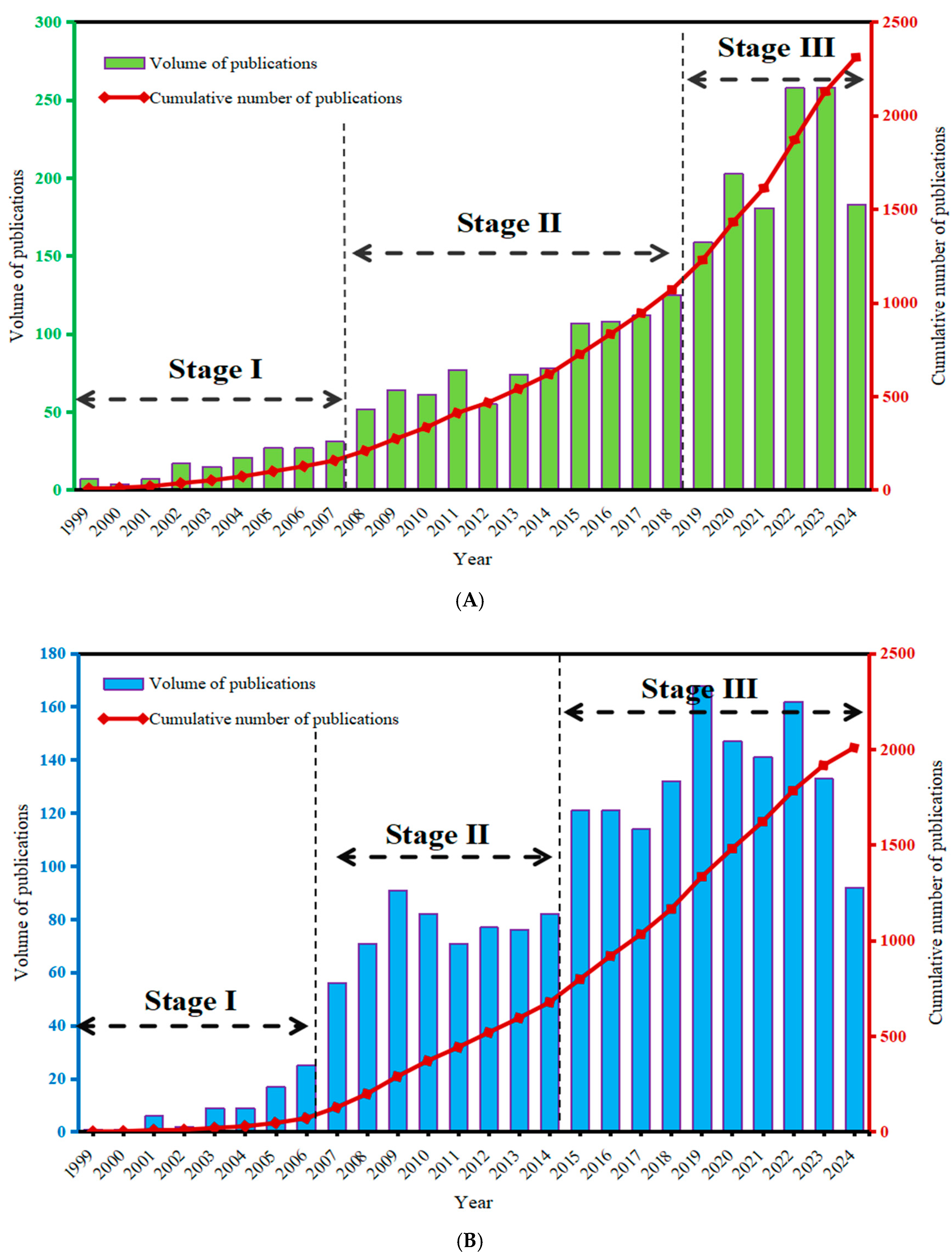
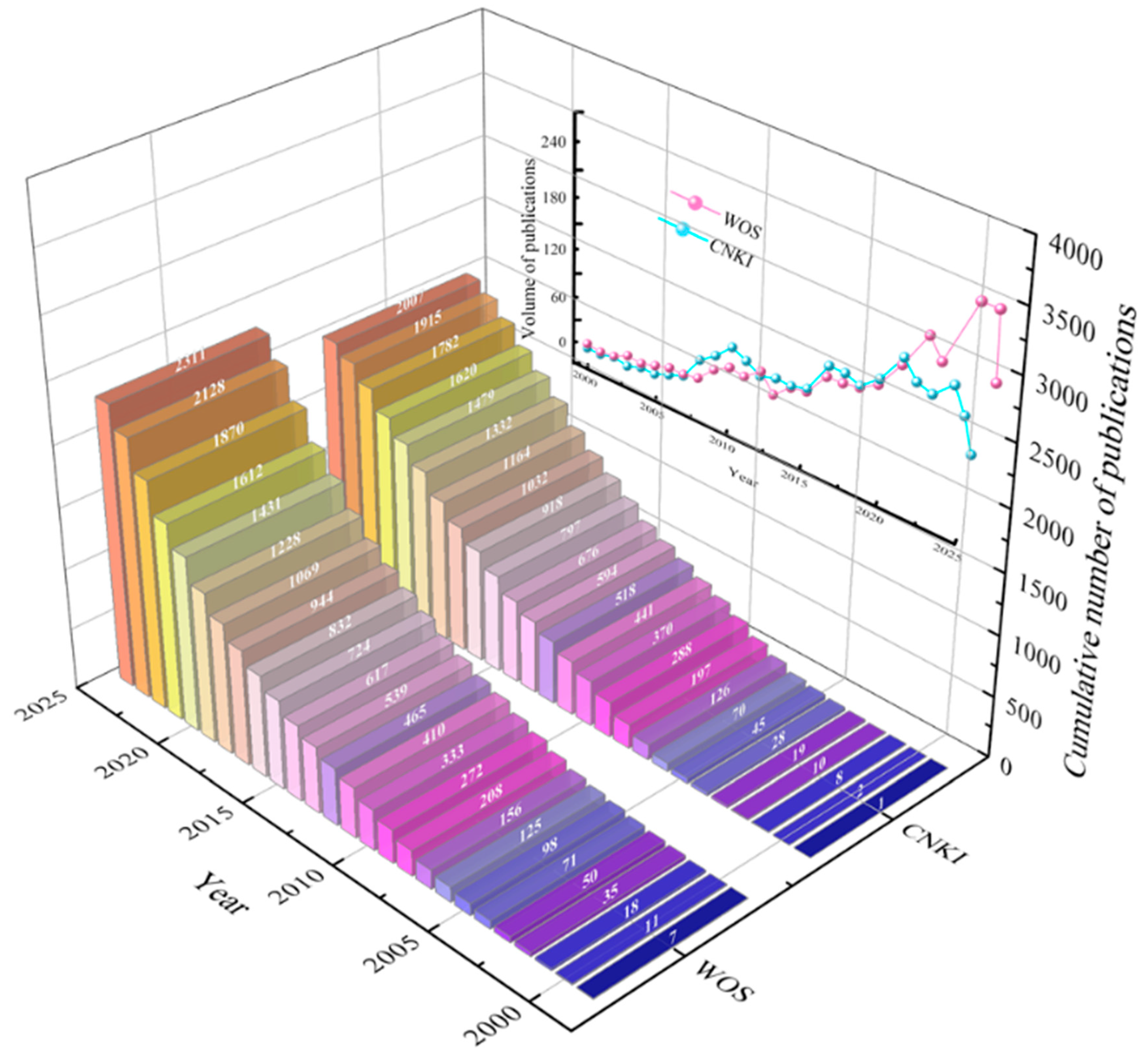
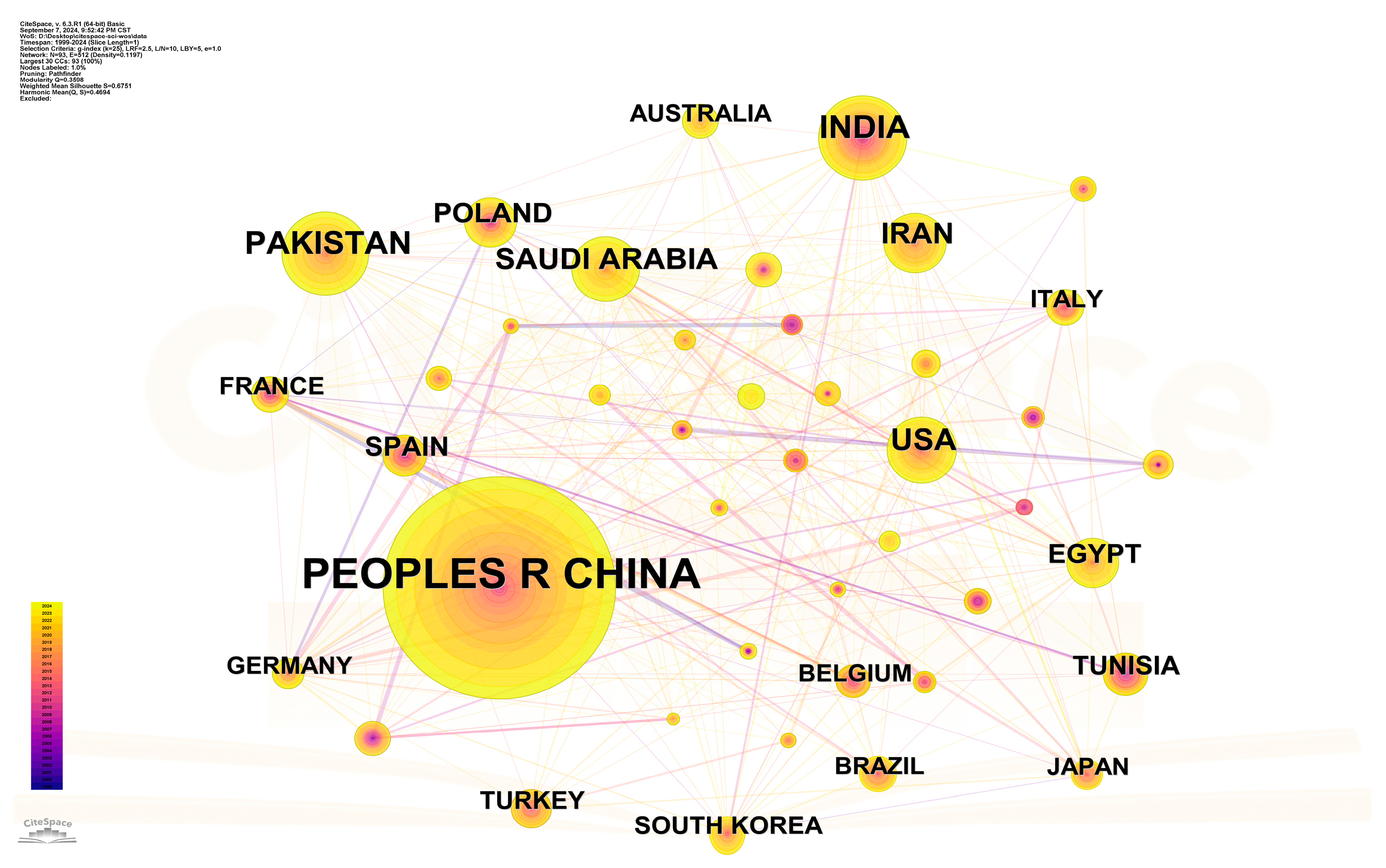
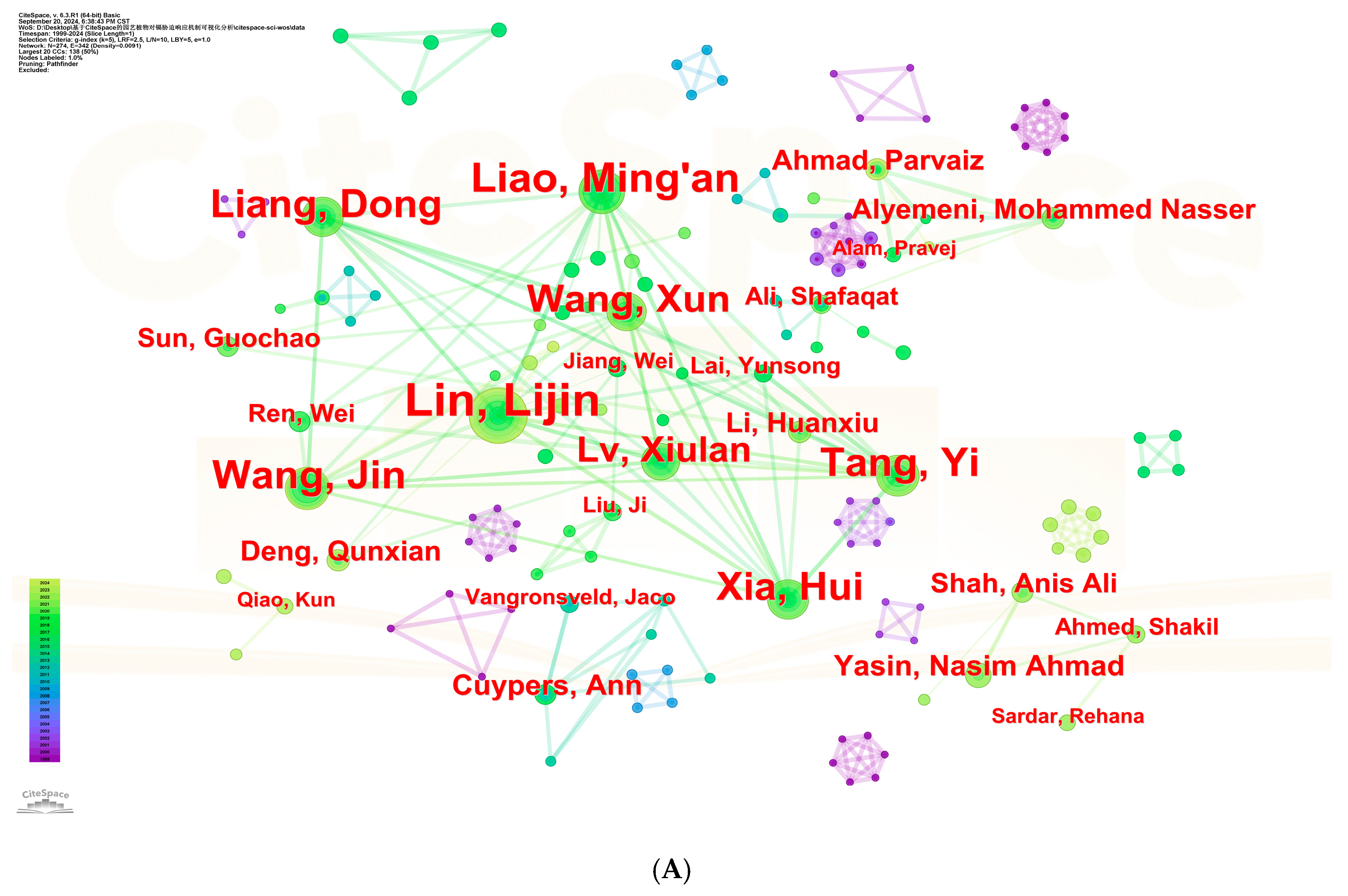
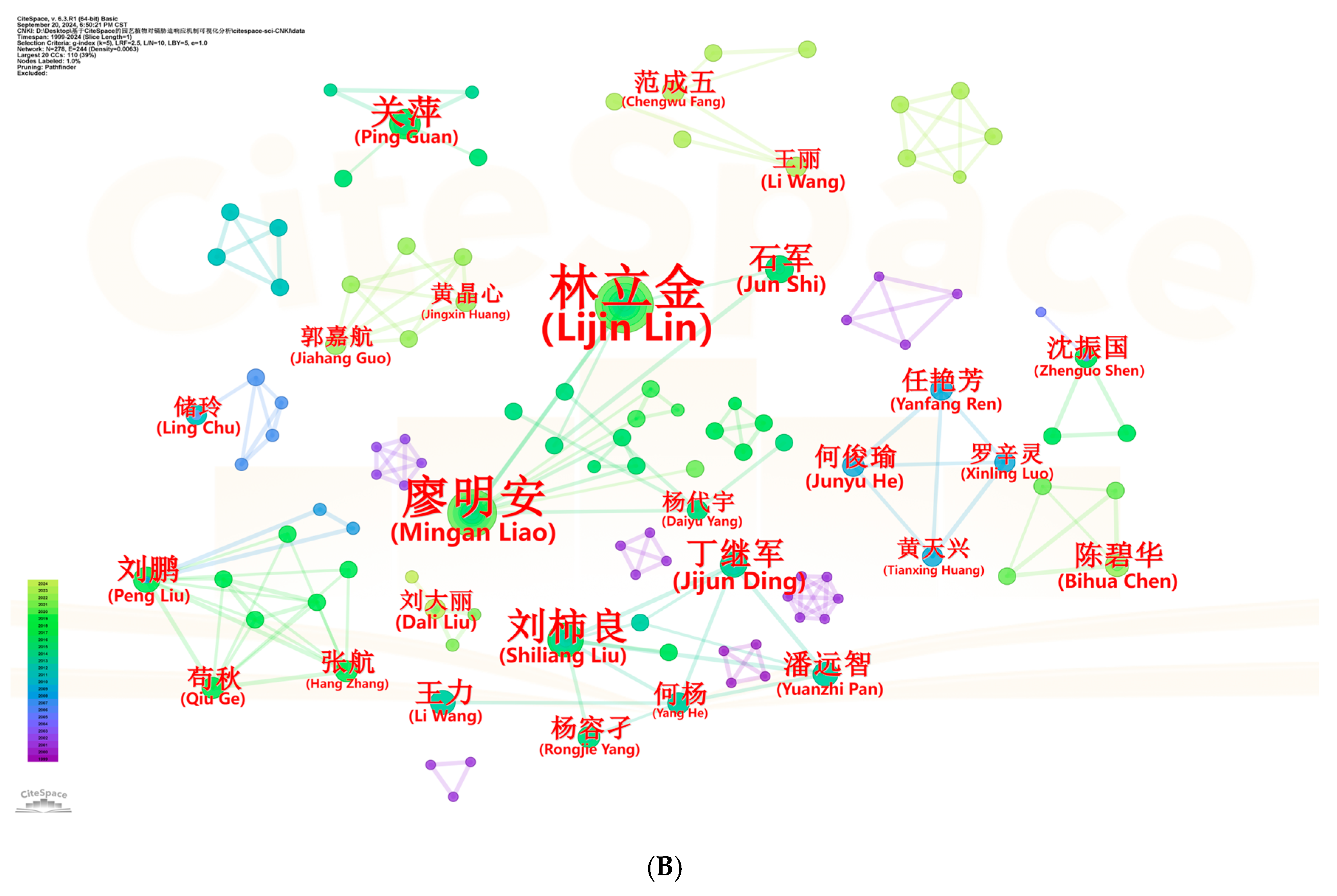

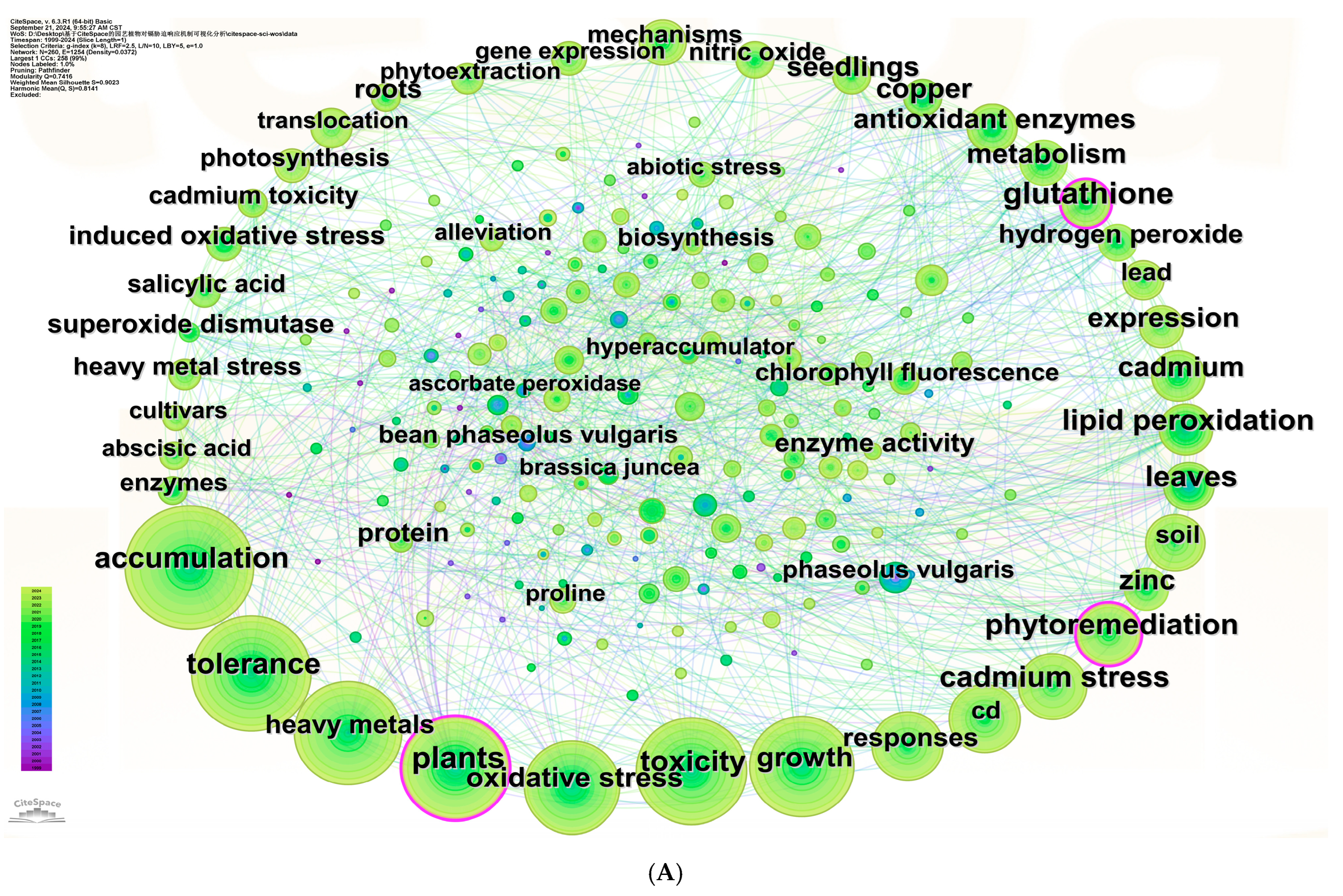
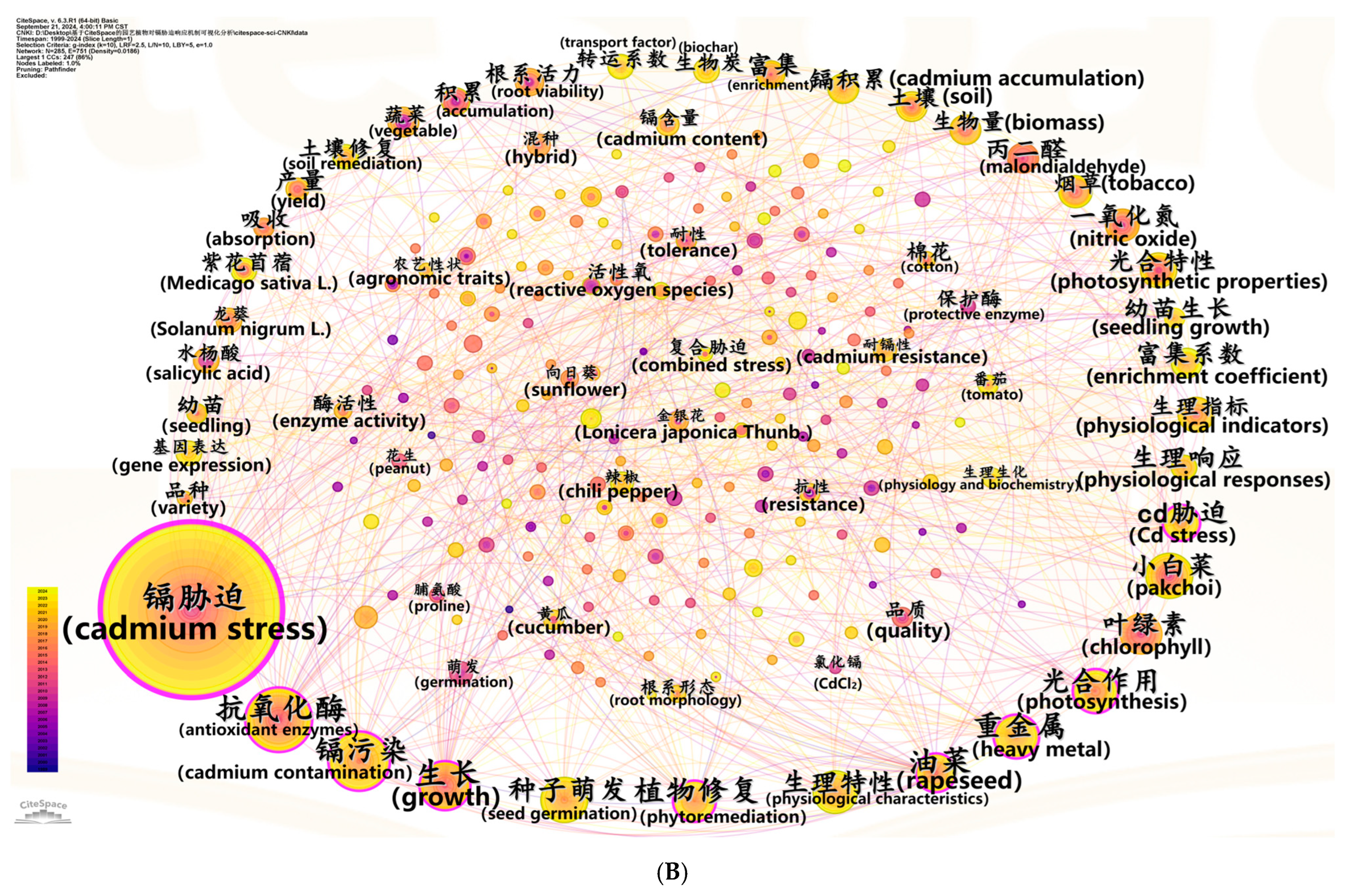
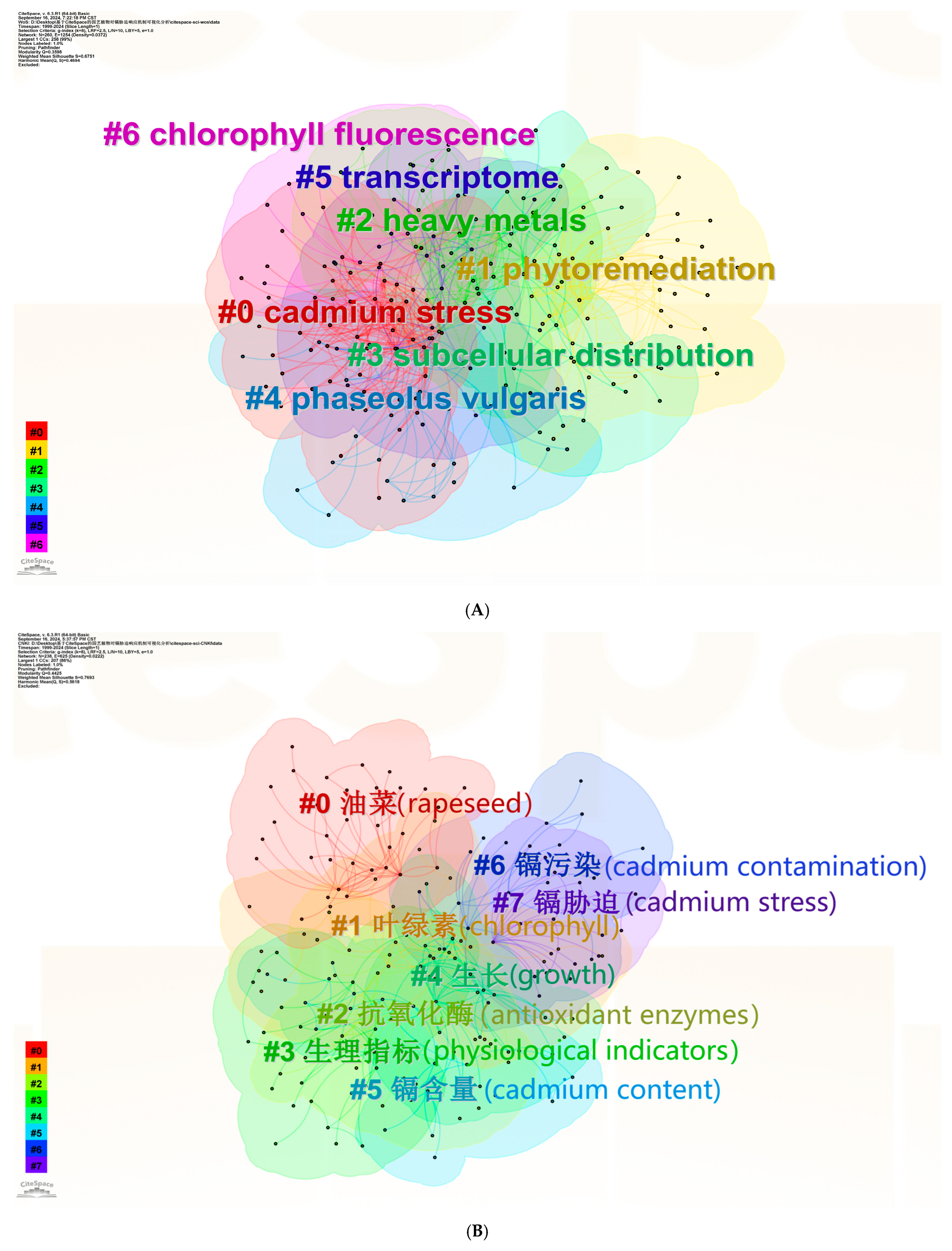
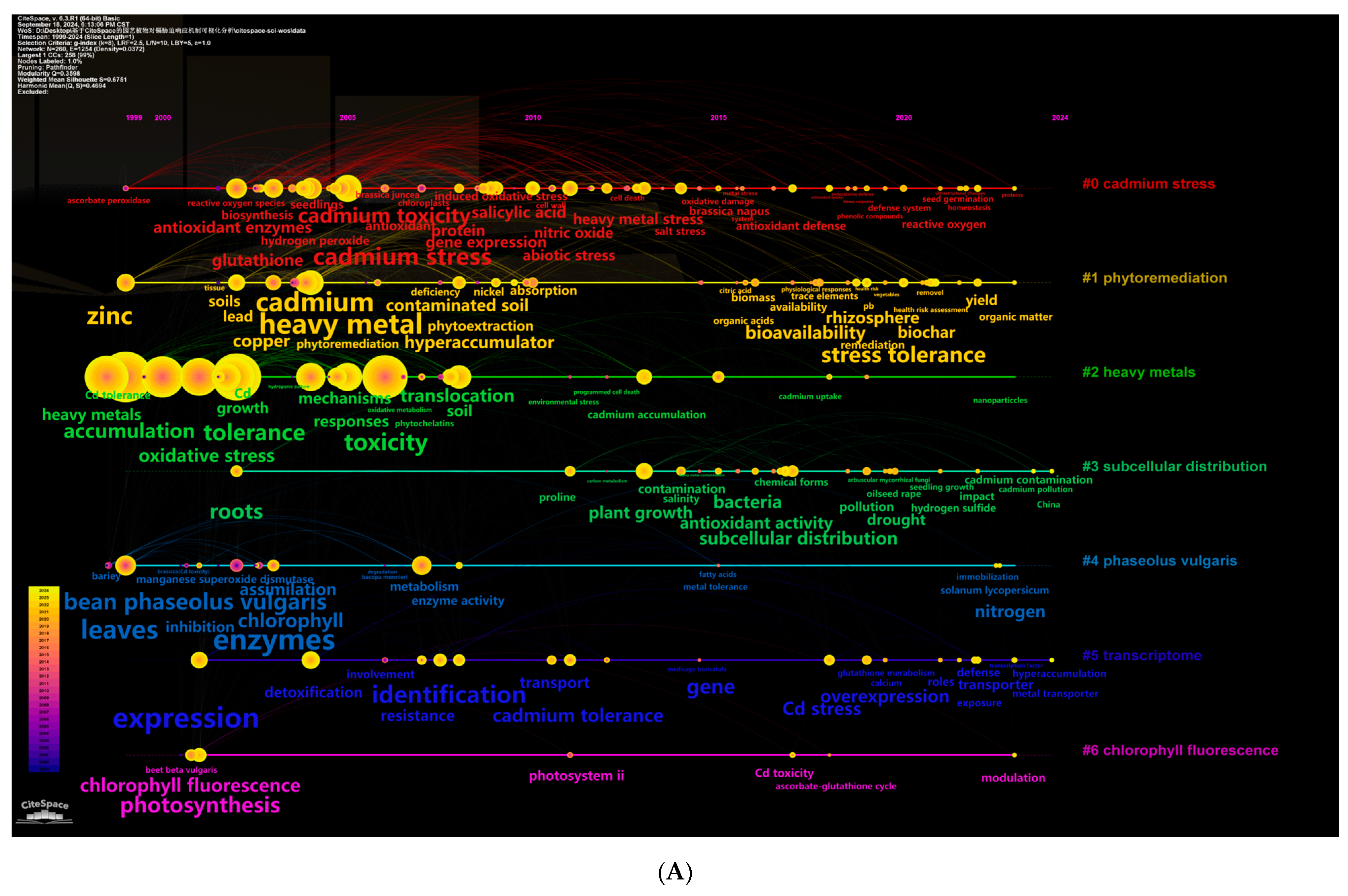
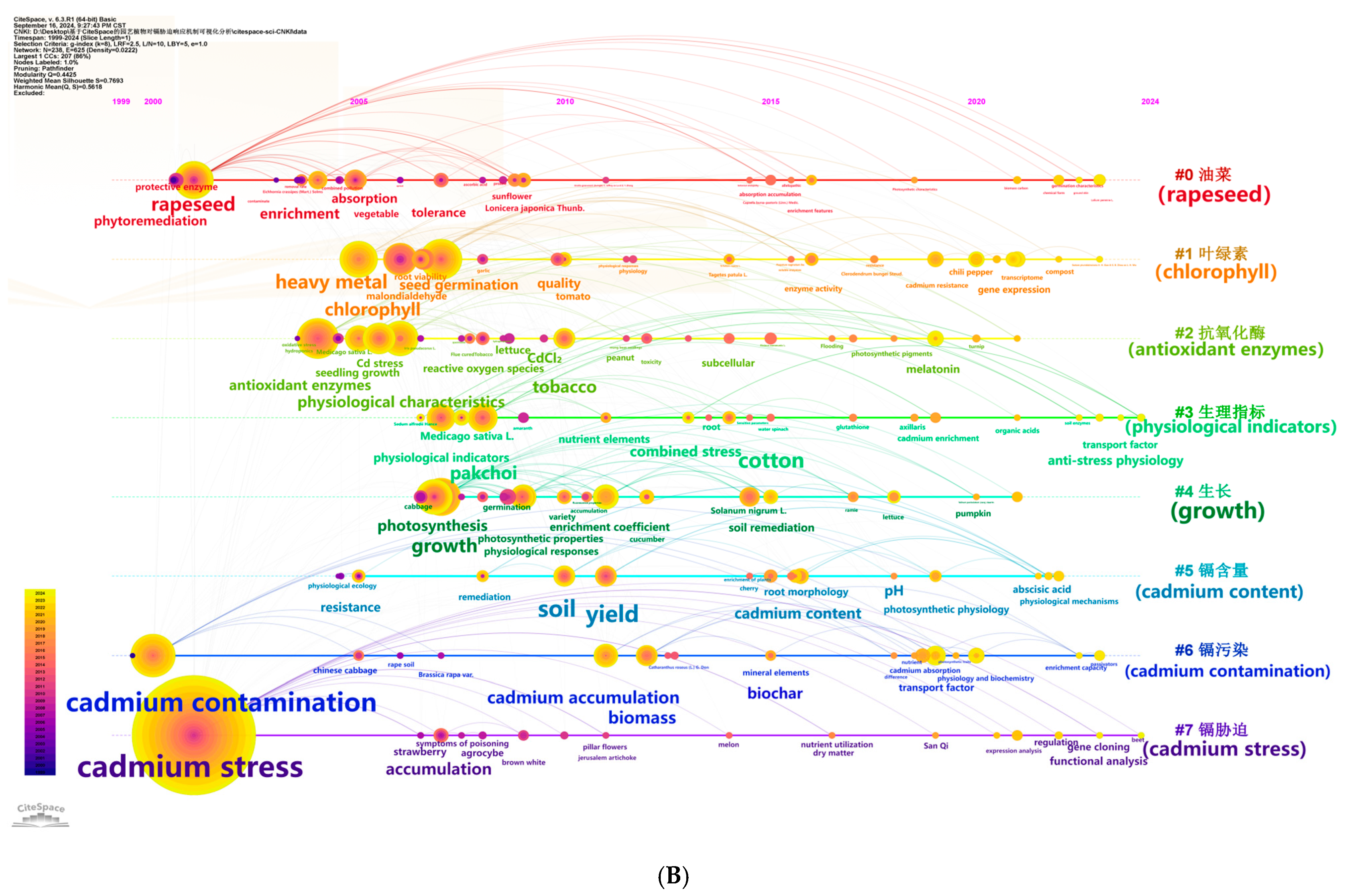
| Years | 1999 | 2000 | 2001 | 2002 | 2003 | 2004 | 2005 | 2006 | 2007 |
| WOS | 7 | 4 | 7 | 17 | 15 | 21 | 27 | 27 | 31 |
| CNKI | 1 | 1 | 6 | 2 | 9 | 9 | 17 | 25 | 56 |
| Years | 2008 | 2009 | 2010 | 2011 | 2012 | 2013 | 2014 | 2015 | 2016 |
| WOS | 52 | 64 | 61 | 77 | 55 | 74 | 78 | 107 | 108 |
| CNKI | 71 | 91 | 82 | 71 | 77 | 76 | 82 | 121 | 121 |
| Years | 2017 | 2018 | 2019 | 2020 | 2021 | 2022 | 2023 | 2024 | |
| WOS | 112 | 125 | 159 | 203 | 181 | 258 | 258 | 183 | |
| CNKI | 114 | 132 | 168 | 147 | 141 | 162 | 133 | 92 |
| Rank | Countries | Publication Number | Percentage (%) | First Published Year |
|---|---|---|---|---|
| 1 | PEOPLES R CHINA | 1165 | 52.79 | 2002 |
| 2 | INDIA | 200 | 9.06 | 1999 |
| 3 | PAKISTAN | 176 | 7.97 | 2008 |
| 4 | USA | 144 | 6.52 | 2001 |
| 5 | SAUDI ARABIA | 120 | 5.44 | 2011 |
| 6 | IRAN | 105 | 4.76 | 2002 |
| 7 | POLAND | 88 | 3.99 | 2001 |
| 8 | EGYPT | 73 | 3.31 | 2009 |
| 9 | SPAIN | 72 | 3.26 | 1999 |
| 10 | TUNISIA | 64 | 2.90 | 2003 |
| WOS | CNKI | ||||||
|---|---|---|---|---|---|---|---|
| Rank | Author | Quantity | Year | Rank | Author | Quantity | Year |
| 1 | Lin L | 75 | 2015 | 1 | Lin L | 35 | 2013 |
| 2 | Liao M | 43 | 2014 | 2 | Liao M | 25 | 2013 |
| 3 | Wang J | 38 | 2016 | 3 | Liu S | 14 | 2013 |
| 4 | Tang Y | 37 | 2016 | 4 | Guan P | 10 | 2014 |
| 5 | Xia H | 34 | 2016 | 5 | Shi J | 8 | 2015 |
| 6 | Liang D | 34 | 2016 | 6 | Ding J | 8 | 2013 |
| 7 | Wang X | 33 | 2017 | 7 | Liu P | 7 | 2008 |
| 8 | Lv X | 25 | 2016 | 8 | Wang L | 6 | 2013 |
| 9 | Cuypers A | 12 | 2010 | 9 | Pan Z | 6 | 2013 |
| 10 | Yasin NA | 12 | 2020 | 10 | Chen B | 6 | 2020 |
| Database | Rank | Research Institute | Count | Year |
|---|---|---|---|---|
| WOS | 1 | Chinese Academy of Sciences | 159 | 2004 |
| 2 | Sichuan Agricultural University | 139 | 2014 | |
| 3 | Zhejiang University | 81 | 2002 | |
| 4 | King Saud University | 72 | 2011 | |
| 5 | Egyptian Knowledge Bank (EKB) | 71 | 2011 | |
| 6 | Nanjing Agricultural University | 70 | 2008 | |
| 7 | Ministry of Agriculture & Rural Affairs | 65 | 2009 | |
| 8 | Chinese Academy of Agricultural Sciences | 51 | 2009 | |
| 9 | University of Chinese Academy of Sciences | 46 | 2005 | |
| 10 | University of Agriculture Faisalabad | 46 | 2015 | |
| CNKI | 1 | College of Horticulture, Sichuan Agricultural University | 37 | 2013 |
| 2 | Institute of Fruits and Vegetables, Sichuan Agricultural University | 31 | 2015 | |
| 3 | College of Landscape Architecture, Sichuan Agricultural University | 23 | 2013 | |
| 4 | College of Life Sciences, Guizhou University | 16 | 2014 | |
| 5 | Graduate School of Chinese Academy of Sciences | 14 | 2009 | |
| 6 | College of Life Science and Technology, Xinxiang University | 13 | 2016 | |
| 7 | College of Resources and Environment, Yunnan Agricultural University | 12 | 2012 | |
| 8 | College of Horticulture and Landscape Architecture, Henan University of Science and Technology | 11 | 2020 | |
| 9 | Shenyang Institute of Applied Ecology, Chinese Academy of Sciences | 10 | 2007 | |
| 10 | College of Life Sciences, Nanjing Agricultural University | 9 | 2003 |
| Title | Author | Year | Journal | Article Types | Institutions | Journal Impact Factor (5 Years) | Citation | Reference |
|---|---|---|---|---|---|---|---|---|
| The effects of cadmium toxicity | Genchi, G. et al. | 2020 | International Journal of Environmental Research and Public Health | Review | Università della Calabria | 4.4 | 1124 | [82] |
| Unravelling cadmium toxicity and tolerance in plants: Insight into regulatory mechanisms | Gallego, SM. et al. | 2012 | Environmental and Experimental Botany | Review | Universidad de Buenos Aires | 5.2 | 891 | [83] |
| Cadmium in soils and groundwater: A review | Kubier, A. et al. | 2019 | Applied Geochemistry | Review | University of Bremen | 3.4 | 634 | [84] |
| Cadmium toxicity in plants: Impacts and remediation strategies | Haider, FU. et al. | 2021 | Ecotoxicology and Environmental Safety | Review | Gansu Agricultural University | 6.3 | 618 | [85] |
| Cadmium in plants: uptake, toxicity, and its interactions with selenium fertilizers | Ismael, MA. et al. | 2019 | Metallomics | Critical Review | Huazhong Agricultural University | 3.7 | 386 | [86] |
| Cadmium bioavailability, uptake, toxicity and detoxification in soil-plant system | Shahid, M. et al. | 2017 | Reviews of Environmental Contamination and Toxicology | Review | COMSATS Institute of Information Technology | 7.1 | 369 | [87] |
| A critical review on effects, tolerance mechanisms and management of cadmium in vegetables | Rizwan, M. et al. | 2017 | Chemosphere | Critical Review | Government College University | 7.7 | 341 | [88] |
| Cadmium stress in plants: A critical review of the effects, mechanisms, and tolerance strategies | El Rasafi, T. et al. | 2020 | Critical Reviews in Environmental Science and Technology | Critical Review | University Mohammed 6 Polytechnic | 14.5 | 243 | [89] |
| Morphological and physiological responses of plants to cadmium yoxicity: A review | He, SY. et al. | 2017 | Pedosphere | Review | Zhejiang Gongshang University | 5.3 | 238 | [90] |
| Toxicity of cadmium and its competition with mineral nutrients for uptake by plants: A review | Qin, SY. et al. | 2020 | Pedosphere | Review | Henan Agricultural University | 5.3 | 237 | [91] |
| Database | Rank | Keyword | Count | Centrality | Year |
|---|---|---|---|---|---|
| WOS | 1 | accumulation | 752 | 0.08 | 1999 |
| 2 | tolerance | 587 | 0.08 | 2002 | |
| 3 | heavy metals | 562 | 0.05 | 1999 | |
| 4 | oxidative stress | 505 | 0.04 | 2001 | |
| 5 | toxicity | 496 | 0.05 | 2006 | |
| 6 | growth | 493 | 0.05 | 2002 | |
| 7 | responses | 270 | 0.05 | 2005 | |
| 8 | Cd | 269 | 0.03 | 2002 | |
| 9 | cadmium stress | 232 | 0.08 | 2005 | |
| 10 | phytoremediation | 222 | 0.11 | 2004 | |
| CNKI | 1 | cadmium stress | 625 | 0.43 | 2001 |
| 2 | antioxidant enzymes | 115 | 0.16 | 2004 | |
| 3 | cadmium contamination | 104 | 0.13 | 2000 | |
| 4 | growth | 91 | 0.16 | 2007 | |
| 5 | seed germination | 90 | 0.06 | 2007 | |
| 6 | phytoremediation | 85 | 0.14 | 2001 | |
| 7 | rapeseed | 83 | 0.18 | 2001 | |
| 8 | physiological characteristics | 79 | 0.08 | 2006 | |
| 9 | heavy metal | 78 | 0.08 | 2005 | |
| 10 | photosynthesis | 63 | 0.09 | 2007 |
| Database | Label | Node | S Value | Mean (Year) | Keywords |
|---|---|---|---|---|---|
| WOS | #0 | 65 | 0.622 | 2011 | cadmium stress (48.72, 1.0 × 10−4; nitric oxide (37.96, 1.0 × 10−4); antioxidant enzymes (33.25, 1.0 × 10−4); gene expression (24.24, 1.0 × 10−4); phytoremediation (20.33, 1.0 × 10−4) |
| #1 | 62 | 0.658 | 2012 | phytoremediation (65.32, 1.0 × 10−4); cadmium stress (41.58, 1.0 × 10−4); oxidative stress (35.32, 1.0 × 10−4); hyperaccumulator (33.78, 1.0 × 10−4); ornamental plant (32.78, 1.0 × 10−4) | |
| #2 | 35 | 0.798 | 2005 | heavy metals (20.15, 1.0 × 10−4); nutrients (14.44, 0.001); yield (12.66, 0.001); root morphology (12.03, 0.001); nutrient uptake (12.03, 0.001) | |
| #3 | 32 | 0.689 | 2017 | subcellular distribution (24.82, 1.0 × 10−4); antioxidant activity (17.15, 1.0 × 10−4); piriformospora indica (9.58, 0.005); pectin (9.24, 0.005); heavy metals accumulation (9.24, 0.005) | |
| #4 | 28 | 0.654 | 2005 | phaseolus vulgaris (10.17, 0.005); nitrogen metabolism (9.49, 0.005); senescence (9.18, 0.005); glutamine synthetase (9.18, 0.005); ammonium (9.18, 0.005) | |
| #5 | 27 | 0.625 | 2015 | transcriptome (31.09, 1.0 × 10−4); cd stress (21.63, 1.0 × 10−4); qrt-pcr (19.03, 1.0 × 10−4); genes (14.27, 0.001); expression pattern (14.27, 0.001) | |
| #6 | 9 | 0.865 | 2010 | chlorophyll fluorescence (31.64, 1.0 × 10−4); ascorbate-glutathione cycle (20.61, 1.0 × 10−4); photosynthesis (14.08, 0.001); stomatal conductance (12.75, 0.001); spectral reflectance (12.75, 0.001) | |
| CNKI | #0 | 33 | 0.809 | 2010 | rapeseed (81.78, 1.0 × 10−4); phytoremediation (76.45, 1.0 × 10−4); cadmium (34.73, 1.0 × 10−4); cadmium stress (29.26, 1.0 × 10−4); enrichment (28.24, 1.0 × 10−4) |
| #1 | 31 | 0.798 | 2013 | chlorophyll (51.5, 1.0 × 10−4); stress (42.96, 1.0 × 10−4); malondialdehyde (34.65, 1.0 × 10−4); heavy metal (33.31, 1.0 × 10−4); seed germination (31.06, 1.0 × 10−4) | |
| #2 | 31 | 0.794 | 2010 | antioxidant enzymes (39.92, 1.0 × 10−4); physiological characteristics (39.56, 1.0 × 10−4); Cd stress (38.7, 1.0 × 10−4); reactive oxygen species (28.2, 1.0 × 10−4); seedling growth (24.37, 1.0 × 10−4) | |
| #3 | 24 | 0.684 | 2016 | physiological indicators (58.05, 1.0 × 10−4); pakchoi (50.45, 1.0 × 10−4); nutrient elements (16.25, 1.0 × 10−4); seedling (13.61, 0.001); cotton (12.54, 0.001) | |
| #4 | 23 | 0.836 | 2011 | growth (66.1, 1.0 × 10−4); photosynthetic properties (29.97, 1.0 × 10−4); photosynthesis (28.68, 1.0 × 10−4); enrichment coefficient (24.04, 1.0 × 10−4); physiological responses (18.38, 1.0 × 10−4) | |
| #5 | 22 | 0.753 | 2015 | cadmium content (23.78, 1.0 × 10−4); biochar (22.5, 1.0 × 10−4); yield (20.38, 1.0 × 10−4); soil (18.49, 1.0 × 10−4); resistance (17.07, 1.0 × 10−4) | |
| #6 | 22 | 0.83 | 2013 | cadmium contamination (78.99, 1.0 × 10−4); biomass (25.74, 1.0 × 10−4); physiology and biochemistry (18.42, 1.0 × 10−4); transport factor (17.39, 1.0 × 10−4); cadmium (15.88, 1.0 × 10−4) | |
| #7 | 21 | 0.605 | 2014 | cadmium stress (151, 1.0 × 10−4); cadmium (54.98, 1.0 × 10−4); cadmium contamination (24.91, 1.0 × 10−4); heavy metal (17.4, 1.0 × 10−4); Cd stress (12.6, 0.001) |
| Top 20 Keywords with the Strongest Citation Bursts (A) | |||||
| Keywords | Year | Strength | Begin | End | 1999–2024 |
| leaves | 1999 | 28.2 | 1999 | 2012 | ▃▃▃▃▃▃▃▃▃▃▃▃▃▃▂▂▂▂▂▂▂▂▂▂▂▂ |
| zinc | 1999 | 11.13 | 1999 | 2012 | ▃▃▃▃▃▃▃▃▃▃▃▃▃▃▂▂▂▂▂▂▂▂▂▂▂▂ |
| bean phaseolus vulgaris | 1999 | 8.69 | 1999 | 2010 | ▃▃▃▃▃▃▃▃▃▃▃▃▂▂▂▂▂▂▂▂▂▂▂▂▂▂ |
| copper | 2003 | 15.34 | 2003 | 2015 | ▂▂▂▂▃▃▃▃▃▃▃▃▃▃▃▃▃▂▂▂▂▂▂▂▂▂ |
| chlorophyll | 2003 | 7.56 | 2003 | 2013 | ▂▂▂▂▃▃▃▃▃▃▃▃▃▃▃▂▂▂▂▂▂▂▂▂▂▂ |
| thlaspi caerulescens | 2004 | 12.27 | 2004 | 2014 | ▂▂▂▂▂▃▃▃▃▃▃▃▃▃▃▃▂▂▂▂▂▂▂▂▂▂ |
| lipid peroxidation | 2004 | 9.99 | 2004 | 2014 | ▂▂▂▂▂▃▃▃▃▃▃▃▃▃▃▃▂▂▂▂▂▂▂▂▂▂ |
| superoxide dismutase | 2004 | 8.98 | 2007 | 2011 | ▂▂▂▂▂▂▂▂▃▃▃▃▃▂▂▂▂▂▂▂▂▂▂▂▂▂ |
| metabolism | 2007 | 8.22 | 2007 | 2011 | ▂▂▂▂▂▂▂▂▃▃▃▃▃▂▂▂▂▂▂▂▂▂▂▂▂▂ |
| hydrogen peroxide | 2004 | 8.17 | 2007 | 2012 | ▂▂▂▂▂▂▂▂▃▃▃▃▃▃▂▂▂▂▂▂▂▂▂▂▂▂ |
| nickel | 2008 | 6.74 | 2008 | 2016 | ▂▂▂▂▂▂▂▂▂▃▃▃▃▃▃▃▃▃▂▂▂▂▂▂▂▂ |
| hyperaccumulator | 2010 | 7.49 | 2010 | 2015 | ▂▂▂▂▂▂▂▂▂▂▂▃▃▃▃▃▃▂▂▂▂▂▂▂▂▂ |
| metal accumulation | 2010 | 7.88 | 2016 | 2019 | ▂▂▂▂▂▂▂▂▂▂▂▂▂▂▂▂▂▃▃▃▃▂▂▂▂▂ |
| induced oxidative stress | 2009 | 7.19 | 2016 | 2018 | ▂▂▂▂▂▂▂▂▂▂▂▂▂▂▂▂▂▃▃▃▂▂▂▂▂▂ |
| brassica napus | 2009 | 6.84 | 2017 | 2020 | ▂▂▂▂▂▂▂▂▂▂▂▂▂▂▂▂▂▂▃▃▃▃▂▂▂▂ |
| rhizosphere | 2018 | 8.07 | 2018 | 2020 | ▂▂▂▂▂▂▂▂▂▂▂▂▂▂▂▂▂▂▂▃▃▃▂▂▂▂ |
| subcellular distribution | 2017 | 7.07 | 2019 | 2021 | ▂▂▂▂▂▂▂▂▂▂▂▂▂▂▂▂▂▂▂▂▃▃▃▂▂▂ |
| oilseed rape | 2020 | 6.78 | 2020 | 2021 | ▂▂▂▂▂▂▂▂▂▂▂▂▂▂▂▂▂▂▂▂▂▃▃▂▂▂ |
| biochar | 2021 | 7.62 | 2021 | 2024 | ▂▂▂▂▂▂▂▂▂▂▂▂▂▂▂▂▂▂▂▂▂▂▃▃▃▃ |
| yield | 2022 | 7.89 | 2022 | 2024 | ▂▂▂▂▂▂▂▂▂▂▂▂▂▂▂▂▂▂▂▂▂▂▂▃▃▃ |
| Top 20 Keywords with the Strongest Citation Bursts (B) | |||||
| Keywords | Year | Strength | Begin | End | 1999–2024 |
| rapeseed | 2001 | 7.23 | 2001 | 2011 | ▂▂▃▃▃▃▃▃▃▃▃▃▃▂▂▂▂▂▂▂▂▂▂▂▂▂ |
| protective enzyme | 2001 | 5.36 | 2001 | 2011 | ▂▂▃▃▃▃▃▃▃▃▃▃▃▂▂▂▂▂▂▂▂▂▂▂▂▂ |
| vegetable | 2005 | 4.66 | 2005 | 2009 | ▂▂▂▂▂▂▃▃▃▃▃▂▂▂▂▂▂▂▂▂▂▂▂▂▂▂ |
| chlorophyll | 2006 | 7.08 | 2006 | 2017 | ▂▂▂▂▂▂▂▃▃▃▃▃▃▃▃▃▃▃▃▂▂▂▂▂▂▂ |
| accumulation | 2007 | 3.87 | 2007 | 2015 | ▂▂▂▂▂▂▂▂▃▃▃▃▃▃▃▃▃▂▂▂▂▂▂▂▂▂ |
| cabbage | 2007 | 3.64 | 2007 | 2011 | ▂▂▂▂▂▂▂▂▃▃▃▃▃▂▂▂▂▂▂▂▂▂▂▂▂▂ |
| malondialdehyde | 2007 | 5.7 | 2008 | 2016 | ▂▂▂▂▂▂▂▂▂▃▃▃▃▃▃▃▃▃▂▂▂▂▂▂▂▂ |
| growth | 2007 | 4.69 | 2008 | 2012 | ▂▂▂▂▂▂▂▂▂▃▃▃▃▃▂▂▂▂▂▂▂▂▂▂▂▂ |
| germination | 2009 | 4.89 | 2009 | 2012 | ▂▂▂▂▂▂▂▂▂▂▃▃▃▃▂▂▂▂▂▂▂▂▂▂▂▂ |
| quality | 2010 | 3.65 | 2010 | 2015 | ▂▂▂▂▂▂▂▂▂▂▂▃▃▃▃▃▃▂▂▂▂▂▂▂▂▂ |
| phytoremediation | 2001 | 3.82 | 2015 | 2018 | ▂▂▂▂▂▂▂▂▂▂▂▂▂▂▂▂▃▃▃▃▂▂▂▂▂▂ |
| Solanum nigrum L. | 2015 | 3.68 | 2015 | 2017 | ▂▂▂▂▂▂▂▂▂▂▂▂▂▂▂▂▃▃▃▂▂▂▂▂▂▂ |
| cadmium content | 2016 | 3.49 | 2016 | 2018 | ▂▂▂▂▂▂▂▂▂▂▂▂▂▂▂▂▂▃▃▃▂▂▂▂▂▂ |
| cadmium accumulation | 2011 | 3.66 | 2018 | 2022 | ▂▂▂▂▂▂▂▂▂▂▂▂▂▂▂▂▂▂▂▃▃▃▃▃▂▂ |
| transport factor | 2019 | 4.94 | 2019 | 2024 | ▂▂▂▂▂▂▂▂▂▂▂▂▂▂▂▂▂▂▂▂▃▃▃▃▃▃ |
| cadmium absorption | 2019 | 4.82 | 2019 | 2020 | ▂▂▂▂▂▂▂▂▂▂▂▂▂▂▂▂▂▂▂▂▃▃▂▂▂▂ |
| chili pepper | 2020 | 4.48 | 2020 | 2021 | ▂▂▂▂▂▂▂▂▂▂▂▂▂▂▂▂▂▂▂▂▂▃▃▂▂▂ |
| physiological responses | 2009 | 4.18 | 2020 | 2021 | ▂▂▂▂▂▂▂▂▂▂▂▂▂▂▂▂▂▂▂▂▂▃▃▂▂▂ |
| gene expression | 2021 | 5.52 | 2021 | 2024 | ▂▂▂▂▂▂▂▂▂▂▂▂▂▂▂▂▂▂▂▂▂▂▃▃▃▃ |
| transcriptome | 2021 | 4.6 | 2021 | 2024 | ▂▂▂▂▂▂▂▂▂▂▂▂▂▂▂▂▂▂▂▂▂▂▃▃▃▃ |
Disclaimer/Publisher’s Note: The statements, opinions and data contained in all publications are solely those of the individual author(s) and contributor(s) and not of MDPI and/or the editor(s). MDPI and/or the editor(s) disclaim responsibility for any injury to people or property resulting from any ideas, methods, instructions or products referred to in the content. |
© 2024 by the authors. Licensee MDPI, Basel, Switzerland. This article is an open access article distributed under the terms and conditions of the Creative Commons Attribution (CC BY) license (https://creativecommons.org/licenses/by/4.0/).
Share and Cite
Liu, Z.; Hu, B.; Zhao, Y.; Zhang, S.; Duan, X.; Liu, H.; Meng, L. Visual Analysis of Research Progress on the Impact of Cadmium Stress on Horticultural Plants over 25 Years. Horticulturae 2025, 11, 28. https://doi.org/10.3390/horticulturae11010028
Liu Z, Hu B, Zhao Y, Zhang S, Duan X, Liu H, Meng L. Visual Analysis of Research Progress on the Impact of Cadmium Stress on Horticultural Plants over 25 Years. Horticulturae. 2025; 11(1):28. https://doi.org/10.3390/horticulturae11010028
Chicago/Turabian StyleLiu, Zhouli, Benyang Hu, Yi Zhao, Shuyan Zhang, Xiangbo Duan, Hengyu Liu, and Luyang Meng. 2025. "Visual Analysis of Research Progress on the Impact of Cadmium Stress on Horticultural Plants over 25 Years" Horticulturae 11, no. 1: 28. https://doi.org/10.3390/horticulturae11010028
APA StyleLiu, Z., Hu, B., Zhao, Y., Zhang, S., Duan, X., Liu, H., & Meng, L. (2025). Visual Analysis of Research Progress on the Impact of Cadmium Stress on Horticultural Plants over 25 Years. Horticulturae, 11(1), 28. https://doi.org/10.3390/horticulturae11010028







